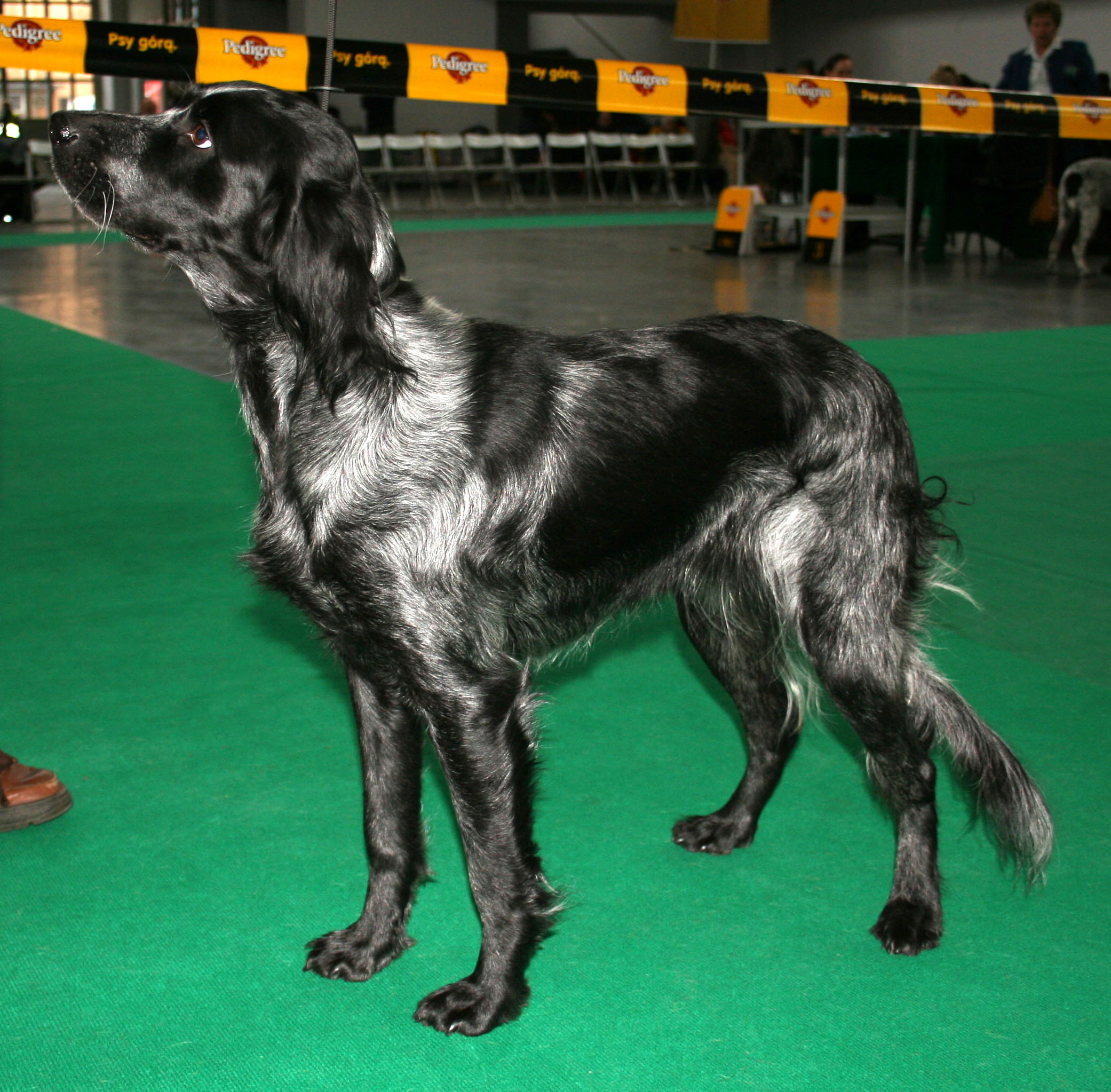
If you're considering bringing a Picardy Spaniel puppy into your family, you're likely wondering what to expect. They are a rare breed, but with the right care and attention, they can make wonderful companions.
Picardy Spaniels are medium-sized dogs with a gentle and affectionate nature. They are relatively low-maintenance pets, requiring daily walks and playtime to stay happy and healthy.
These puppies are born with a thick coat that requires regular grooming to prevent matting.
Take a look at this: Dogs Breeds That Start with B
Appearance
The Picardy Spaniel puppy you're about to bring home is a beautiful breed with a sturdy build and a loving personality. Their average height at the withers is between 22-24 inches (56-61 cm), making them a medium-sized dog.
Their coat is one of their defining features, with a bluish shade due to grey and black speckles. The coat is flat or slightly wavy, with feathering on the ears, legs, and tail.
You'll notice their long, broad muzzles and large, dark eyes that cast a calm expression. Their ears sit just above eye level and reach the tip of their muzzles when stretched.
A Picardy Spaniel's weight typically ranges from 20-25 kilograms (44-55 lb), making them a sturdy but not overly large breed. Their muscular body and powerful limbs make them a great companion for outdoor activities.
Their coat can vary in colors from chocolate, chestnut brown, and white with sandy-colored markings on the head and white or grey spots on the legs. Their hair is abundant with a slight wave, enabling them to work in dense cover and even in water.
Both the forequarters and the hindquarters are well-muscled, giving them a balanced and athletic appearance. Their tail typically does not extend beyond the hock and is normally straight.
Temperament
The Picardy Spaniel is a docile breed of dog, fond of playing with children and bonding well with their master. They have a gentle sociable nature and are relatively easy to train.
Their temperament is characterized by a laid-back attitude, making them a great fit for families with young children. They are also quiet and will let you know if a stranger comes around.
Here are some key traits to consider when getting a Picardy Spaniel puppy:
- Playful and calm
- Generally friendly and gentle
- Good with children and other pets
- Quiet, but will alert you to strangers
- Responsive and obedient
This breed requires regular exercise, but they don't need a large amount of space, making them suitable for city life as long as they're taken on regular walks.
Blue History
The Blue Picardy Spaniel's history is a fascinating one. They originated in the Picardy area due to quarantine restrictions in the UK, where hunters would board their dogs instead of bringing them home.
Their distinctive black and blue/grey coat was a result of crossing with local Picardy Spaniels. This unique coloring eventually led to their classification as a separate breed.
The breed faced extinction after World War II, but thanks to a few dedicated breeders, they were saved. Their numbers are slowly increasing, making them popular as both hunting dogs and companion pets.
In 1996, the United Kennel Club recognized the breed, giving them official recognition.
Temperament & Intelligence
The Picardy Spaniel is a docile breed of dog that's perfect for families. They're fond of playing with children and bond well with their master.

This breed is relatively easy to train, as they were bred to listen to people and follow commands. They're not as high-strung as some other dogs, making them a great choice for first-time dog owners.
Picardy Spaniels are gentle and sociable, thriving on human companionship. They're especially good with children and make loyal family companions.
They require regular exercise, but they don't need a large amount of space. In fact, they're perfectly suitable for city life, as long as they're taken on regular walks.
Here are some key characteristics of the Picardy Spaniel's temperament:
- Docile and gentle
- Relatively easy to train
- Good with children
- Thrives on human companionship
- Quiet, but will alert you to strangers
- Adaptable and laid-back
Overall, the Picardy Spaniel is a versatile breed that's well-suited for families and hunting alike.
Health
The Picardy Spaniel is generally a healthy breed with an average lifespan of 14 years. However, being a hunting spaniel with pendulous ears, they are prone to ear infections, which are common among breeds with similar ear structures.
Overfeeding your Picardy Spaniel can lead to obesity, a common health issue that can be prevented with careful feeding.
You might enjoy: Ear Cropping Presa Canario
Entropion and hip dysplasia are potential health concerns for this breed, although many breeders check for hip dysplasia and it's not a serious issue in all lines.
To keep your Picardy Spaniel healthy, be mindful of their diet and exercise needs, and make sure to clean their ears regularly to prevent infections.
Here are some health issues to be aware of in the Picardy Spaniel breed:
- Ear infections
- Entropion
- Hip dysplasia
Blue Traits
The Blue Picardy Spaniel's distinctive coloring is a result of its history, where boarded dogs crossed with local Picardy Spaniels, introducing a black and blue/grey coat into the gene pool.
This unique coloring has actually helped the breed gain classification as a separate breed due to its distinctive coloring.
The Blue Picardy Spaniel's rarity as a gundog made it vulnerable to extinction after World War II, but a concerted effort by breeders saved the breed.
As a result, the breed is becoming popular as both hunting dogs and companion pets, with their numbers slowly increasing.
Health

The Picardy Spaniel is generally a healthy breed, with an average lifespan of 14 years. However, they can be prone to ear infections, especially with their long, pendulous ears.
Their ears trap dirt and debris, which can lead to infections, so regular cleaning is essential. Overfeeding can also lead to overweight, which can cause health problems.
Hip dysplasia is another potential issue, but most breeders check for it, and it's not a serious problem in all lines. Entropion and similar diseases can also occur in some lines.
To keep your Picardy Spaniel healthy, it's essential to maintain a healthy weight through regular exercise and a balanced diet. Regular veterinary check-ups can also help identify any potential health issues early on.
Here are some potential health issues to be aware of:
- Ear infections
- Entropion
- Hip dysplasia
- Obesity
Frequently Asked Questions
How much does a Picardy Spaniel cost?
A Blue Picardy Spaniel typically costs between $900 to $1,200, depending on its quality. Learn more about the factors that influence the price of this breed.
Are Picardy spaniels good dogs?
Yes, Picardy Spaniels are known for their gentle and sociable nature, making them a great breed for families with children. They are also relatively easy to train and bond well with their owners.
What is the lifespan of a Picardy Spaniel?
A Picardy Spaniel typically lives for about 14 years, which is a relatively long lifespan for a large breed.
Do picardy spaniels point or flush?
Picardy Spaniels are known to point game, often standing up and displaying a stylish stance, rather than flushing. They are also natural retrievers with a soft mouth.
Do Picardy spaniels shed?
Yes, Picardy Spaniels shed seasonally, specifically during spring and autumn. Regular grooming can help manage their shedding.
Featured Images: pexels.com
